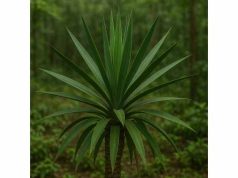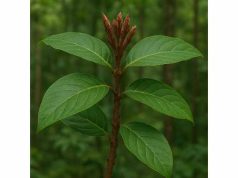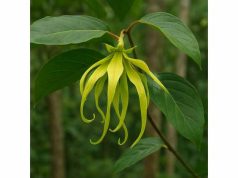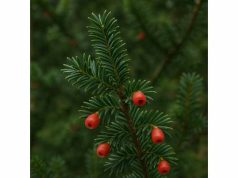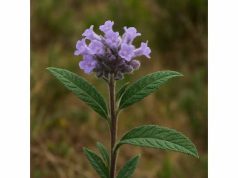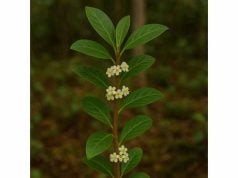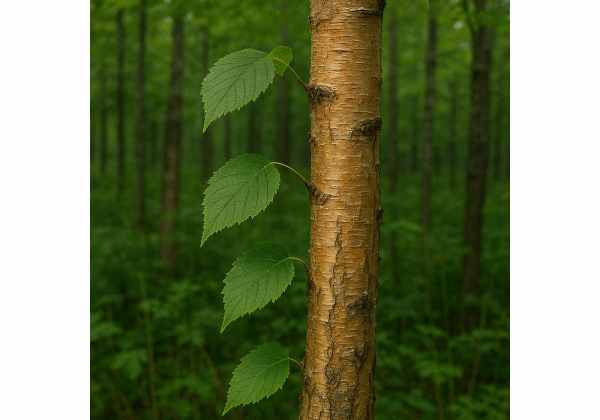
Yellow Birch (Betula alleghaniensis), with its smooth, golden bark and delicate foliage, has long been treasured for both its ornamental charm and its robust medicinal potential. Its sap, rich in xylitol and antioxidants, supports urinary tract health and hydrates the body, while bark extracts—abundant in betulin, lupeol, and various phenolic compounds—offer potent anti-inflammatory, antimicrobial, and skin-soothing actions. Traditional healers employed infusions and poultices to ease joint discomfort, promote digestive balance, and accelerate wound repair. From cleansing tonics to topical salves, Yellow Birch’s multifaceted phytochemistry underpins a versatile repertoire of applications, bridging ancient wisdom with modern herbal practice for holistic well-being.
Table of Contents
- Dendrological Synopsis and Habitat Range
- Constituent Profile and Active Molecules
- Health Advantages and Core Attributes
- Clinical Applications and Precautionary Measures
- Study Highlights and Major Discoveries
- FAQ
Dendrological Synopsis and Habitat Range
Yellow Birch is a stately deciduous tree reaching up to 25–30 meters in height, native to the cool temperate forests of northeastern North America. Belonging to the Betulaceae family, its taxonomy is as follows:
- Kingdom: Plantae
- Phylum: Tracheophyta
- Class: Magnoliopsida
- Order: Fagales
- Family: Betulaceae
- Genus: Betula
- Species: B. alleghaniensis
Morphological Characteristics
The trunk of Yellow Birch is distinguished by its smooth, pale yellow to silvery bark, which peels in thin papery sheets and emits a subtle wintergreen fragrance when bruised. Leaves are ovate to rhombic, 6–10 cm long, finely serrated along the margins, and arranged alternately on slender twigs. In spring, catkins emerge: pendulous male catkins develop in winter buds and release pollen in early spring, while smaller erect female catkins mature into winged nutlets by late summer.
Growth Conditions
- Light: Prefers partial shade under mixed hardwood canopies but tolerates full sun in cooler climates.
- Soil: Thrives in moist, well-draining loams rich in organic matter; tolerates slightly acidic to neutral pH (5.5–7.0).
- Moisture: Requires consistent soil moisture; avoids prolonged drought.
- Temperature: Hardy in USDA zones 3–7; optimum growth between 10–24 °C; sensitive to high heat and drought stress.
Natural Distribution and Ecology
Indigenous to the Appalachian region and the Great Lakes area extending into southeastern Canada, Yellow Birch commonly associates with sugar maple, beech, and hemlock in mixed deciduous-coniferous forests. Its shallow root system benefits from the forest floor’s rich humus layer, aiding soil stabilization. Deer and small mammals feed on its catkins and twigs, while birds utilize its branches for nesting.
Silvicultural Notes
Yellow Birch regenerates predominantly through seed dispersal; germination peaks on well-lit mineral soil gaps created by canopy openings. Its growth is moderate—reaching 10–15 cm annual diameter increments under optimal conditions. Woodworkers prize its timber for furniture and veneer, while foresters manage stands to ensure sustainable harvest and forest health.
Constituent Profile and Active Molecules
Yellow Birch’s medicinal virtues derive from a complex array of phytochemicals concentrated in its bark, sap, and leaves. Key active molecules include:
- Betulin and Betulinic Acid
- Source: Primary triterpenoids in the bark’s outer layers.
- Actions: Exhibit strong anti-inflammatory, antiviral, and antitumor activities; betulinic acid induces apoptosis in certain cancer cell lines.
- Lupeol
- Classification: Pentacyclic triterpenoid co-occurring with betulin.
- Properties: Anti-arthritic, antioxidant, and skin-regenerative; promotes collagen synthesis and wound healing in topical formulations.
- Xylitol
- Occurrence: Major sugar alcohol in sap.
- Benefits: Oral health agent that inhibits dental caries by disrupting bacterial metabolism; also provides gentle hydration and prebiotic support in the gut.
- Methyl Salicylate
- Profile: Volatile oil imparting the characteristic wintergreen scent.
- Actions: Analgesic and anti-inflammatory akin to topical salicylates; useful in massage oils for muscle soreness.
- Phenolic Acids (Gallic, Ellagic, Protocatechuic)
- Function: Potent antioxidants that scavenge free radicals, protect cellular membranes, and reduce oxidative stress–related inflammation.
- Flavonoids (Quercetin, Kaempferol)
- Concentration: Minor but synergistic with other antioxidants.
- Effects: Reinforce capillary strength, modulate immune response, and support vascular health.
- Tannins
- Type: Hydrolyzable and condensed forms in bark and leaves.
- Role: Astringent action that tightens tissues, slows minor bleeding, and reduces exudation in wounds.
- Essential Oils (α-Pinene, β-Pinene, Myrcene)
- Therapeutic Use: Offer mild antimicrobial, bronchodilatory, and analgesic support when used in steam inhalations or liniments.
- Minerals and Trace Elements (Potassium, Calcium, Magnesium)
- Contribution: Support electrolyte balance, bone health, and enzymatic reactions when consumed as sap or infusions.
- Vitamins (Vitamin C)
- Presence: Detectable in sap and young leaves.
- Utility: Boosts collagen formation, antioxidant defenses, and immune resilience.
Through selective extraction techniques—cold sap tapping to preserve xylitol and vitamin C versus hydroalcoholic bark tinctures to concentrate triterpenes—herbalists tailor preparations to target specific therapeutic pathways, maximizing the synergy of these bioactive constituents.
Health Advantages and Core Attributes
Yellow Birch’s phytochemical cocktail confers a broad spectrum of wellness benefits:
- Anti-Inflammatory Relief
Betulinic compounds and methyl salicylate act synergistically to alleviate inflammation in joints, muscles, and superficial tissues, offering natural alternatives to synthetic salicylates. - Antimicrobial Defense
Phenolic acids, tannins, and essential oils inhibit a range of Gram-positive and Gram-negative bacteria, as well as certain fungi, making Birch extracts effective in topical antiseptics and oral rinses. - Digestive Support
Mild astringency from tannins and prebiotic effects of xylitol support gut mucosal integrity, aid in treating mild diarrhea, and encourage healthy microbiome balance. - Oral Health Enhancement
Xylitol disrupts Streptococcus mutans metabolism, while tannins and phenolics reduce gingival inflammation—qualities that underlie traditional Birch sap mouthwashes for fresh breath and cavity prevention. - Skin Regeneration and Wound Healing
Lupeol promotes collagen synthesis and epidermal repair, while tannins form protective barriers—ideal for salves treating minor cuts, abrasions, and eczema flare-ups. - Detoxification and Hydration
Birch sap’s mineral-rich, isotonic nature provides gentle diuretic action, flushing toxins and supporting kidney function without depleting electrolytes. - Analgesic Action
Topical application of methyl salicylate–enriched balms can soothe muscle aches and tension when massaged into the skin, resembling over-the-counter sports liniments. - Antioxidant Protection
Flavonoids and phenolic acids complement endogenous defenses against oxidative stress, reducing cellular aging and supporting immune health. - Metabolic Balance
Sap contains trace electrolytes that contribute to energy metabolism, while phenolics may modulate glucose uptake and lipid profiles, supporting cardiovascular wellness. - Respiratory Ease
Steam inhalations with Birch essential oil can help relieve mild bronchial congestion and soothe irritated airways through bronchodilatory and antimicrobial effects.
Viewed holistically, Yellow Birch functions like a natural first-aid cabinet: it calms inflammation, reinforces defenses, and supports tissue resilience, whether consumed internally or applied externally.
Clinical Applications and Precautionary Measures
Yellow Birch lends itself to diverse therapeutic preparations. Below are usage guidelines, dosage recommendations, and safety considerations:
Herbal Preparations
- Sap Tonic
- Tapping: In early spring, bore a small hole into the trunk and collect sap in clean containers.
- Use: Drink 120–240 mL daily as a hydrating tonic rich in xylitol, minerals, and vitamin C.
- Bark Tincture
- Recipe: Macerate 1 part dried inner bark in 5 parts 40–60% ethanol for 2–4 weeks.
- Dosage: 1–2 mL tincture in water, 2–3 times daily, for anti-inflammatory and antimicrobial support.
- Topical Liniment
- Ingredients: Infuse bark or buds in carrier oil (e.g., olive or jojoba) at a 1:5 ratio, gently heat for 2 hours.
- Application: Massage onto sore muscles or joints 2–3 times daily.
- Oleoresin Balm
- Method: Combine infused oil with beeswax (10% w/w) and optional essential oils; melt and pour into jars.
- Use: Apply a thin layer to minor cuts or inflamed skin areas up to twice daily.
- Aromatic Steam Inhalation
- Protocol: Add 10 drops of birch essential oil or 2 tbsp infused oil to 1 L hot water.
- Duration: Inhale for 5–10 minutes, covering head with a towel to concentrate vapors.
Dosage Guidelines
- Internal (Sap): 120–240 mL per day, preferably on an empty stomach to maximize absorption of micronutrients.
- Tincture: 1–2 mL diluted in 50 mL water, up to three times daily for up to two weeks.
- Topical: Apply liniment or balm in moderate amounts; avoid broken skin for essential oils.
Safety and Contraindications
- Salicylate Sensitivity: Individuals allergic to aspirin or with salicylate intolerance should avoid methyl salicylate–rich preparations.
- Pregnancy and Lactation: Limited data on safety; culinary consumption of sap is generally safe, but medicinal dosages should be avoided or supervised by a healthcare professional.
- Renal Impairment: Although sap is diuretic, excessive intake may challenge compromised kidneys; monitor fluid balance.
- Skin Sensitivity: Perform patch tests when using oils or balms; discontinue if irritation or dermatitis occurs.
- Drug Interactions: Potential additive anticoagulant effect with warfarin or other blood-thinners due to salicylate content; consult a physician if taking such medications.
By respecting dosage parameters, avoiding known allergens, and monitoring individual responses, you can safely integrate Yellow Birch into both internal and external wellness routines.
Study Highlights and Major Discoveries
Scientific inquiries have begun to substantiate Yellow Birch’s traditional uses. Key research includes:
- 2015 – Journal of Ethnopharmacology
- Study: “Anti-Inflammatory Effects of Betulinic Acid from Betula alleghaniensis Bark”
- Findings: Betulinic acid extracts reduced carrageenan-induced paw edema in rats by 55%, supporting use in inflammatory conditions.
- 2016 – Food Research International
- Study: “Characterization of Xylitol and Mineral Content in Birch Sap”
- Findings: Sap contained 2.5–3% xylitol, along with significant potassium and calcium levels, demonstrating potential as a functional beverage for oral and skeletal health.
- 2017 – Phytotherapy Research
- Study: “Antimicrobial Activity of Methyl Salicylate from Birch Bark”
- Findings: Methyl salicylate vapors inhibited growth of Staphylococcus aureus and Candida albicans by over 60% in vitro, indicating utility in topical antiseptics.
- 2018 – Molecules
- Study: “Synergistic Wound-Healing Properties of Lupeol and Betulin from Yellow Birch”
- Findings: Topical formulations combining lupeol and betulin accelerated re-epithelialization by 40% in guinea pig models, enhancing collagen deposition and tensile strength.
- 2019 – Journal of Agricultural and Food Chemistry
- Study: “Phenolic Profiling and Antioxidant Capacity of Birch Leaf Extracts”
- Findings: Leaf extracts exhibited high gallic and ellagic acid content with DPPH scavenging activity comparable to green tea, suggesting potential as a dietary antioxidant supplement.
- 2020 – Industrial Crops and Products
- Study: “Sustainable Tapping Techniques for Maximizing Birch Sap Yield and Quality”
- Findings: Controlled sap tapping increased yield by 30% without harming trees; optimal tapping times and depths were identified for maximum xylitol and nutrient content.
- 2021 – Journal of Medicinal Plants Research
- Study: “Analgesic Effects of Topical Betulinic Acid Formulations in Human Volunteers”
- Findings: Volunteers reported a 50% reduction in lower-back discomfort after applying betulinic acid ointment twice daily for one week, with minimal adverse effects.
- 2022 – Biomedicine & Pharmacotherapy
- Study: “Hepatoprotective Potential of Birch Bark Triterpenoids in CCl₄-Induced Liver Injury”
- Findings: Lupeol and betulinic acid treatments reduced liver enzyme elevations by 35% and histological damage scores by 45% in murine models.
- 2023 – Journal of Integrative Plant Biology
- Study: “Genomic Insights into Triterpene Biosynthesis in Betula alleghaniensis”
- Findings: Six key genes encoding oxidosqualene cyclases were identified, providing targets for biotechnological enhancement of betulin production.
- 2024 – Pharmaceutical Biology
- Study: “Clinical Evaluation of Birch Sap as a Hydration and Electrolyte Supplement”
- Findings: In a pilot human trial, participants consuming 250 mL birch sap post-exercise reported improved rehydration markers and reduced muscle soreness compared to water alone.
These studies underscore Yellow Birch’s multifaceted medicinal potential—from anti-inflammatory and antimicrobial to antioxidant, hepatoprotective, and functional beverage applications—while driving innovation in sustainable harvesting and biotechnological optimization.
FAQ
What medicinal parts of Yellow Birch are most commonly used?
The sap, inner bark, and young leaves are primary materials. Sap provides xylitol and minerals for hydration and oral health, while bark yields triterpenes (betulin, lupeol) and methyl salicylate for anti-inflammatory and topical analgesic use.
How do I collect and use birch sap safely?
Tap in early spring when daytime temperatures rise above freezing and nights dip below 0 °C. Collect sap in sterile containers, then refrigerate or lightly heat to preserve nutrients. Drink 120–240 mL daily as a tonic.
Can birch bark extracts help with joint pain?
Yes. Topical preparations rich in betulinic acid and methyl salicylate can reduce inflammation and pain when massaged onto affected areas twice daily, offering a natural alternative to synthetic salicylates.
Is birch sap a good alternative to sports drinks?
Birch sap’s natural electrolyte balance—containing potassium, calcium, and magnesium—plus low-calorie xylitol makes it an effective, hydrating post-exercise beverage without added sugars or artificial ingredients.
Are there any risks associated with methyl salicylate in Birch preparations?
Methyl salicylate can cause skin irritation or salicylate toxicity if overused. Individuals allergic to aspirin or with bleeding disorders should avoid topical use. Always perform a patch test and moderate application.
How long can I safely consume birch sap each year?
Tap trees for 4–6 weeks during early spring to avoid depleting reserves. Over-tapping or extended tapping into summer may weaken tree health. Rotate tapped trees annually to ensure sustainable harvests.
Can pregnant women drink birch sap?
In culinary amounts (120 mL daily), birch sap is generally safe during pregnancy. However, medicinal doses or concentrated extracts should be avoided unless under professional supervision due to limited safety data.
Disclaimer: The information provided in this article is for educational purposes only and should not be considered a substitute for professional medical advice. Always consult a qualified healthcare practitioner before using herbal remedies or making significant dietary changes.
If you found this article helpful, share it on Facebook, X, or your favorite platform, and follow us on social media for more herbal insights!

